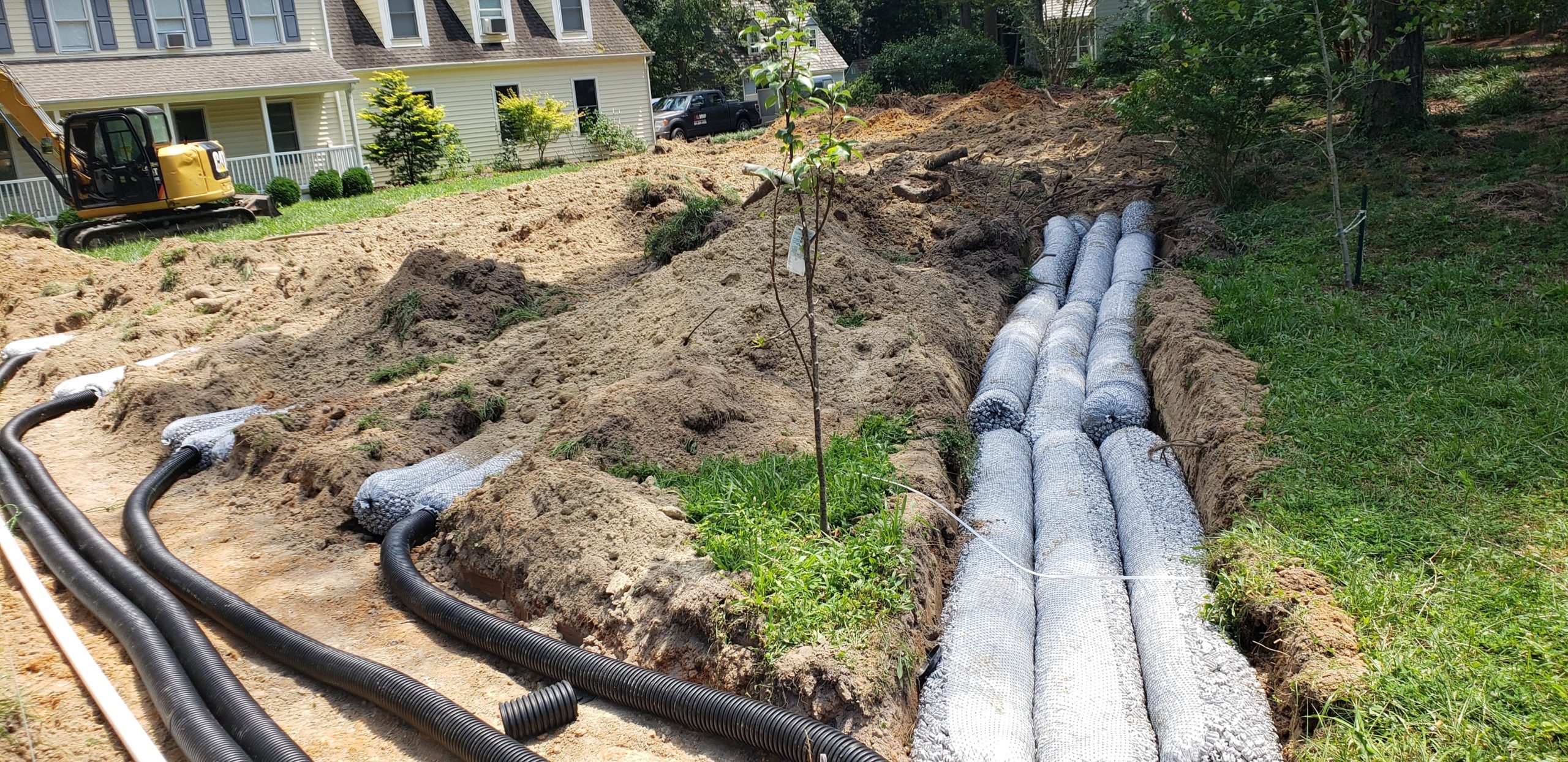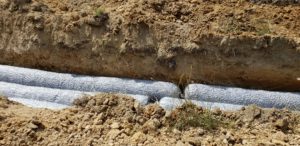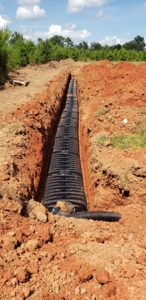
20 Aug 2020 Designing Drainfields in a Limited Area
Limited Area Does Not Mean Limited Options
 Not everyone is lucky enough own a large tract of land with plenty of space to construct a house without needing to consider where to install the onsite septic system. Typically, a house is built on the high spot of a lot, and the drainfield is downslope from the residence to ensure positive drainage. As long as the soils are suitable and the absorption area is adequate for the size of the house, the drainfield usually isn’t given a second thought. As good land is becoming increasingly difficult to obtain, and more and more land is parceled off into subdivision lots to maximize profit margins, trying to squeeze everything on a postage stamp sized lot can be a challenge. However, there are ways to maximize the limited area for a drainfield, while still being able to fully execute one’s construction plans without substitutions or deletions. The following examples are ways to mitigate for lack of area.
Not everyone is lucky enough own a large tract of land with plenty of space to construct a house without needing to consider where to install the onsite septic system. Typically, a house is built on the high spot of a lot, and the drainfield is downslope from the residence to ensure positive drainage. As long as the soils are suitable and the absorption area is adequate for the size of the house, the drainfield usually isn’t given a second thought. As good land is becoming increasingly difficult to obtain, and more and more land is parceled off into subdivision lots to maximize profit margins, trying to squeeze everything on a postage stamp sized lot can be a challenge. However, there are ways to maximize the limited area for a drainfield, while still being able to fully execute one’s construction plans without substitutions or deletions. The following examples are ways to mitigate for lack of area.
Gravelless Technology: GMP 2016-01 issued by the Virginia Department of Health allows for a reduction in square footage of drainfield trench absorption area to a maximum of 25%, when utilizing an approved gravelless product. Approved products include Infiltrator Chambers and EZ Flow. These products allow for additional storage capacity in the absorption trenches, thus not as many absorption trenches are required. Drawbacks to this methodology are the maximum limits to the depths that Chambers and EZ Flow can be installed before compromising the integrity of the products. Also, Chambers have a tendency to become vapor locked if installed improperly or if lacking the proper ventilation.
 Limited Occupancy: Residential drainfields are sized based on the rate of absorption of the insitu soil, and on the total number of bedrooms in the dwelling(s). It is assumed that 2 persons can occupy each bedroom. For design purposes in Virginia, each person or occupant generates wastewater at a rate of 75 gallons per day (GPD). Applying this to practical design, a 4 bedroom residential dwelling would need to be designed for a total of 600 GPD. 4 bedrooms x 2 occupants per bedroom x 75 GPD = 600 GPD. The supporting drainfield would then need to be designed to accommodate daily flows of 600 GPD. However, if limited area is an issue, a deed restriction can be applied to the property which limits the number of occupants while still allowing for the same number of bedrooms. For example, a 4 bedroom residential dwelling with a limited occupancy of 6 persons would only have to be sized and designed for 450 GPD. Though this can be the easiest method of designing drainfields in limited space, this may not be desired because it prevents the opportunity to resell the home to larger families that may exceed the permitted number of occupants.
Limited Occupancy: Residential drainfields are sized based on the rate of absorption of the insitu soil, and on the total number of bedrooms in the dwelling(s). It is assumed that 2 persons can occupy each bedroom. For design purposes in Virginia, each person or occupant generates wastewater at a rate of 75 gallons per day (GPD). Applying this to practical design, a 4 bedroom residential dwelling would need to be designed for a total of 600 GPD. 4 bedrooms x 2 occupants per bedroom x 75 GPD = 600 GPD. The supporting drainfield would then need to be designed to accommodate daily flows of 600 GPD. However, if limited area is an issue, a deed restriction can be applied to the property which limits the number of occupants while still allowing for the same number of bedrooms. For example, a 4 bedroom residential dwelling with a limited occupancy of 6 persons would only have to be sized and designed for 450 GPD. Though this can be the easiest method of designing drainfields in limited space, this may not be desired because it prevents the opportunity to resell the home to larger families that may exceed the permitted number of occupants.
 Pretreatment: Another factor used in determining the required area of absorption of a drainfield is hydraulic and organic loading rate, which is expressed as number of gallons per square feet. Sizing of a conventional drainfield design considers the organic loading, which equates to a larger drainfield in order to dilute that organic loading over a known area. If space is limited, a designer could employ the use of a premanufactured secondary or tertiary treatment unit to pretreat the effluent to cleaner levels. Since, the wastewater effluent is pretreated, and the organic loading is decreased, the hydraulic loading (gallons per foot) can be increased and absorption area can be decreased due to the lack of need for dilution over an area. Pretreatment can be the most environmentally beneficial, as nitrogen levels of effluent are lowered, and Biological Oxygen Demand is decreased to levels lower than basic septic tank effluent. However, pretreatment systems can be costly to install and a fee driven contract to perform an annual inspection and maintenance of the system is required.
Pretreatment: Another factor used in determining the required area of absorption of a drainfield is hydraulic and organic loading rate, which is expressed as number of gallons per square feet. Sizing of a conventional drainfield design considers the organic loading, which equates to a larger drainfield in order to dilute that organic loading over a known area. If space is limited, a designer could employ the use of a premanufactured secondary or tertiary treatment unit to pretreat the effluent to cleaner levels. Since, the wastewater effluent is pretreated, and the organic loading is decreased, the hydraulic loading (gallons per foot) can be increased and absorption area can be decreased due to the lack of need for dilution over an area. Pretreatment can be the most environmentally beneficial, as nitrogen levels of effluent are lowered, and Biological Oxygen Demand is decreased to levels lower than basic septic tank effluent. However, pretreatment systems can be costly to install and a fee driven contract to perform an annual inspection and maintenance of the system is required.
Please contact our qualified design staff of licensed soil evaluators and professional engineers or Shannon Hill if you have a project that requires an onsite septic system.

